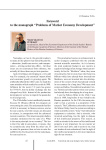Economic and Social Changes: Facts, Trends, Forecast @volnc-esc-en
Статьи журнала - Economic and Social Changes: Facts, Trends, Forecast
Все статьи: 1728
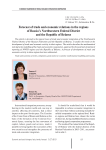
Статья научная
The article is devoted to the topical issues of trade and economic integration of the Northwestern Federal District of the Russian Federation and the Republic of Belarus. It studies the trends in the development of trade and economic activity in their regions. The article describes the mathematical tool of gravity modelling of the trade and economic cooperation, approved by the materials of statistical reporting of NWFD regions and the Republic of Belarus. A forecast of development of trade and economic activity in these regions has been elaborated.
Бесплатно
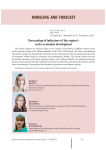
Forecasting of indicators of the region's socio-economic development
Статья научная
The article analyses the statistical data on the volumes of investment in different spheres of the socio-economic system of the Udmurt Republic in the 1996-2010 period. The values of production and human capitals are predicted for the next five years with regard to the forecasting of the dynamics of investment volume based on economic and mathematical models. The article resolves the task of modeling dynamics of the gross regional product in the Udmurt Republic by applying production function constructed on the basis of statistical methods of correlation and regression analysis, and the issue concerning the forecasting of the dynamics of production and human capitals.
Бесплатно
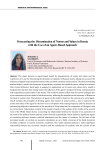
Forecasting the dissemination of norms and values in Russia with the use of an agent-based approach
Статья научная
The paper presents an agent-based model for dissemination of norms and values and the experience of its use for forecasting the dynamics of opinions in Russian society, taking into account the influence of digital media and deterioration of the economic situation in the country. The chosen modeling method helps to predict the dynamics of population, economy and political system, taking into account their mutual influence. Each agent is assigned an appropriate set of norms and values and a model is designed showing how they change under the influence of the agent’s standard of living, communication with acquaintances and impact of the media. The model we present differs from its known analogues due to its connection with the model of artificial society, reflecting the population and economy of Russia on the basis of current data. The behavior of agents in the model is based on the concept of a social agent, which includes the principles of dividing agents into clusters of social activity, a way to represent the norms and values of the agent in the form of a set of options with varying frequency and the function of constructing subjective assessments of the standard of living based on the comparison of the agent with its environment. Information content of the model is based on the analysis of the results of the seventh wave of the World Values Survey concerning the relationship between the income level, assessment of the work of the political system and the norms of social responsibility, which showed a significant degree of correlation between incomes, political assessments and the norms of residents. On the basis of the developed model, we carried out scenario calculations so as to build a forecast of the likely dynamics of public sentiment in various economic conditions. The results obtained indicate a rather significant relationship between the economic situation and the satisfaction of residents with the actions of the government. In the developed model, the change in a person’s beliefs is limited to their inner world; therefore, implementing new aspirations in attempts to change one’s own life or society is an important direction for future research.
Бесплатно
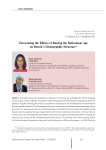
Forecasting the effects of raising the retirement age on Russia's demographic structure
Статья научная
The paper assesses the possibility of raising the retirement age to mitigate the effects of ageing on the pension system of Russia. The authors make demographic forecasts based on hypotheses about the presence of global demographic trends in population reproduction and manifestations of development features specific for Russia. The demographic forecast is based on the age shifting method according to three scenarios. The forecast takes into account the provisions of a draft law that has already been approved and that provides for a gradual increase in age limit for civil servants, both men and women, to 65 years (by six months each year). The following assumption is made for the purpose of studying the effects of raising the retirement age to 65 years for all categories of Russian citizens. The increase in the retirement age begins in 2016 at the rate of 6 months per year, and it will end for men in 2026 and for women - in 2036. Thus, by 2036, the official retirement age will be 65 years for both sexes...
Бесплатно
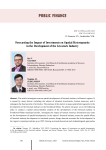
Статья научная
The article investigates uneven spatial development of livestock industry in Russia’s regions. It is caused by many factors, including the volume of attracted investments, human resources; and it endangers the food security of territories. The purpose of the study is to assess spatial heterogeneity in the development of the livestock industry in the Sverdlovsk Oblast. To achieve the goal, we set the following tasks: to conduct a spatial autocorrelation analysis of the development of the livestock industry in Sverdlovsk Oblast municipal entities, investigate the impact of human resources investments and costs on the development of spatial heterogeneity in the region’s livestock industry, assess the spatial effects of livestock industry development in territorial systems, design forecast scenarios for its development in the region’s municipal entities up to 2025. Having reviewed theoretical and methodological approaches to assessing spatial heterogeneity at the regional and municipal levels we find out that Russian and foreign researchers use a variety of methods. Their application does not contribute to the comprehensive assessment of spatial heterogeneity in the development of the livestock industry. To solve the problem, we propose a methodological approach, whose novelty consists in the comprehensive application of spatial autocorrelation analysis methods using various matrices of spatial weights, regression analysis using panel data and ARIMA modeling which, when combined, make it possible to determine the impact of investments and other factors on heterogeneity in the development of the livestock industry in the region’s municipalities and design a system of various forecast scenarios. The regression models we constructed have confirmed the differentiated impact of investments and human resources on spatial heterogeneity in the livestock sector in the Sverdlovsk Oblast and outlined the prospects for its development.
Бесплатно
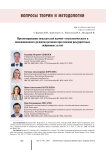
Статья научная
The article forecasts indicators of scientific, technological and innovative development of a constituent entity of the Russian Federation and regional institutions of innovative development using recurrent neural networks. Forecasting using neural networks has become widespread and is a relevant, high-quality and reliable way of making economic forecasts and is applicable within the framework of socio-economic analysis, including analysis ofterritories. However, when studying the scientific literature, it was not possible to find works in which the scientific, technological and innovative development of regions was predicted using the neural network method, which determines the scientific novelty of the research being carried out. The relevance of the study is due to the increasing attention on the part of regional authorities to the scientific, technological and innovative development of territories and the need to form state programs of the constituent entities of the Russian Federation in the field of scientific and technological development. The research hypothesis is that forecasting indicators of scientific, technological and innovative development of the region and the activities of regional institutions for innovative development using recurrent neural networks will give more accurate results than using the linear regression method, moving average model or the Holt - Winters method. As part of the study, a recurrent neural network model was formed based on a system ofinterconnection ofindicators ofscientific, technological and innovative development of a constituent entity of the Russian Federation and regional institutions of innovative development. As a result, a forecast of indicators of scientific, technological and innovative development of a constituent entity of the Russian Federation and the activities of regional institutions for innovative development was obtained, which correlates with the real situation in this area.
Бесплатно
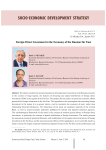
Foreign direct investment in the economy of the Russian Far East
Статья научная
The article considers the trends and patterns of foreign direct investment in the Russian economy in the context of mega-regions, the features of attracting and spatial distribution of foreign direct investment (FDI) in the regions of the Far East. The purpose for the study is to assess the economic effects generated by foreign investment in the Far East. The hypothesis is the assumption that attracting foreign investment in the region is to a greater extent a tool to maximize the economy of scale, rather than eliminating financial imbalances. The initial data of the study are statistical materials of the Central Bank, as well as macroeconomic indicators published by federal and regional statistical agencies. The methodological framework of the study is the concept of modern general theory of foreign direct investment, in particular the concept of spatial distribution of foreign investment. The article presents the assessment results of spatial performance and modification of the spatial-sectoral structure of foreign investment in the Far East, and the macroeconomic effects of their application...
Бесплатно
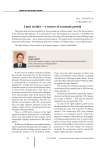
Статья научная
The article is devoted to the urgent research issues on the integration and modelling of foreign economic activity from the little-studied aspect of the system of relations “country - region of another country”. The authors examine the background and the tendencies of development of trade and economic integration of the NWFD regions and the Republic of Belarus. The need for use of mathematic tools to model and to predict the integration processes is founded in the article. The authors describe the mathematic apparatus of gravitation, econometric and inter-branch models. In the range of gravitation model the researchers make regression equations to predict the foreign trade turnover and export of the Republic of Belarus to the Russian Federation.
Бесплатно
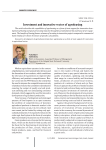
Foreign experience of hydrocarbon resources development at the arctic continental shelf
Статья научная
The article examines the experience of hydrocarbon resources of the Arctic zone of the world's leading oil and gas powers in order to identify effective socio-economic approaches to the development of hydrocarbon deposits in the public interest and possible future use in modern Russian conditions. A comparative analysis of natural resources development models by different states and conclusions about their effectiveness are given. The authors discuss aspects of an effective industrial policy in the upstream oil and gas sector in the region, taking into account a wide range of socio-economic problems in various stages of deposits development. The article also addresses the problems of relationships between the state and the oil and gas business, formation of an effective strategy for managing the development of hydrocarbon resources.
Бесплатно
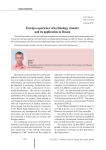
Foreign experience of technology transfer and its application in Russia
Статья научная
The article provides an overview of foreign experience in technology transfer and commercialization. It describes the peculiarities and drawbacks of organizing technology transfer in Russia. In addition, the article proposes the directions for applying foreign experience in the country’s innovation system.
Бесплатно
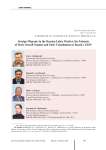
Статья научная
Nowadays Russian Federation is one of the world leaders according to the number of international labor migrants it receives. Russia is among the top ten countries according to the volume of remittances from foreign workers to their countries of origin. However, it is impossible to provide an exact statistical estimate for the total number of foreign citizens working in the Russian labor market since there continue to exist certain legal regimes within the post-Soviet area concerning entry into Russia and staying there. The present research analyzes a methodology for an indirect estimate of the overall number of foreign workers in the Russian labor market. The methodology is based on the data on money transfers to migrants' countries of origin, on the estimate of their income in Russia and on the structure of their usage. The research reveals that according to the “medium scenario” in 2017 there were about 7.2 million foreigners working in Russia, and only 2.9 million of them worked legally. The following conclusion can be made: about 60% of foreign workers in Russia are not included in the data of the Federal State Statistics Service of Russia and the General Administration for Migration Issues under the Ministry of Internal Affairs of the Russian Federation. The estimate of the foreign workers' contribution to Russian GDP is based on the overall number of foreign labor migrants in Russia. According to our estimate, their contribution was around 6.4% in 2017.
Бесплатно
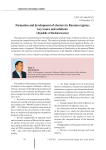
Статья научная
The paper gives substantiation for the implementation of cluster policy in Russia as the key way of increasing the competitiveness of the country. The analysis of foreign and domestic experience of cluster formation was carried out. The concept of cluster supporting framework of the regions of Russia, considering clusters as a node element of the economy and promoting the binding of disparate elements of economic space, is proposed. The algorithm for implementation of cluster policy in the regions of Russia is proposed. The experience of its practical implementation in the Republic of Bashkortostan is given.
Бесплатно
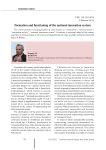
Formation and functioning of the national innovation system
Статья научная
The article presents conceptualization of such notions as “innovation”, “innovativeness”, “innovation activity”, “national innovation system”. It contains a structural model of this system, describes its main functions in the process of implementing the state scientific-technical innovation policy in Belarus.
Бесплатно
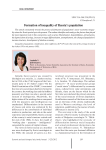
Formation of inequality of Russia's population
Статья научная
The article consistently reveals the process of formation of population’s socio-economic inequa- lity since the Soviet period up to the present. The author identifies and analyzes the factors that played the most important role in this connection, such as price liberalization, hyperinflation, privatization, the depreciation of savings, increase in wages differentiation, unemployment, the change of population’s income structure, development of shadow economy.
Бесплатно
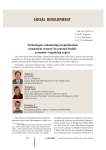
Formation of regional budget in crisis
Статья научная
As is known, in December 2009 Legislative Assembly enacted a law «On Regional Budget for 2010». The budget is formed by the conservative scenario, based on projected economic growth of 2.5%. The analysis of the main financial area of the law, conducted by ITSED RAS, showed that the current year will be a serious test of the regional budget system. The budget deficit of the Vologda region is the highest among the donors regions. It is 28%. Nevertheless, despite the tense situation, the reserves increase revenue and reduce costs in the area are available.
Бесплатно
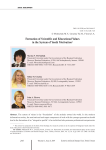
Formation of scientific and educational values in the system of youth motivation
Статья научная
The system of values is the “foundation” of the attitude toward the world. In the modern information society, the motivational and target component of work with the younger generation should lead to the formation of an “integrative profile” of an individual who possesses professional competencies of a high level that are in demand in research and educational spheres, as well as in project activities. Motivation is largely determined not only by internal characteristics of an individual, but also by the ways in which activity is carried out; this activity in the process of its implementation should be targeted, directional, predictable and analytical, with monitoring, evaluation of efficiency and adjustment of its implementation, i.e. it should be conscious activity. Our goal is to identify new mechanisms of state stimulation of topical and priority areas of youth policy in the field of university science and identify possible routes for the development of values. We adhere to the basic idea of the need to take into account value orientations in the development of state youth policy. Desk research and sociological research were used as the main methods of the work. The desk study was conducted by analyzing the main directions of the state policy in the field of science and technology, normative legal acts of the Russian Federation, state programs and projects, and publications of international organizations. The study collected data on existing forms and measures of incentives and support for student youth. In order to test theoretical approaches to motivation and identification of the main factors contributing to youth participation in research activities, a sociological study was conducted among university students.
Бесплатно
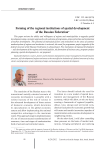
Forming of the regional institutions of spatial development of the Russian Federation
Статья научная
This paper reviews the ability and willingness of regions and municipalities to upgrade spatial development using a systemic approach to the selection of programme-project priorities and institutions of market development. The potential of individual factors and institutions in the areas of systemic modernization of regions and territories is reviewed; the need for programme-project upgrade of the federal structure of the Russian Federation is substantiated. New institutions of regional development - self-development of the regions and municipalities, the formation of business area, program-project planning, spatial development etc. are proposed.
Бесплатно
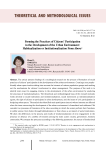
Статья научная
The article presents findings of a sociological research on the process of formation of social practices of citizens’ participation in the development of the urban environment. Creating a new, peoplefriendly urban space involves taking into account the interests of various population groups and working out the mechanisms for citizens’ involvement in urban management. The purpose of the work is to identify main ways for engaging citizens in the development of the urban environment by analyzing the processes of institutionalization. The theoretical and methodological basis of the research includes works devoted to social institutions and institutionalization, social movements as institutionalization agents, the right of citizens to participate in urban development, and the issues of civic participation in designing urban spaces. The analysis has identified main participants (actors) whose interests are affected when the issue concerning the development of the urban environment is formulated and addressed. We consider two processes of formation of the rules according to which the actors perform their functions in public arenas: from below through habitualization or from above as an import of social institutions. We show the differences in the process and results of institutionalization of civic engagement in the presence or absence of a conflict of interests among the main actors: society, government, business community. We compare the processes according to the following parameters: the nature of institutional changes, relations and actions, type of institutional changes, structure of political opportunities, and civic engagement levels. We draw conclusions about how the orientation of the processes affects the nature of civic participation. In particular, the loss of the “partnership” and “delegation of authority” stages in the process of institutionalization from above indicates a formal and imitative nature of the practices of civic participation in urban development. The novelty of the work consists in comparing the oppositely directed processes of institutionalization of civic participation (from below and from above) on the example of a specific sphere such as urban development.
Бесплатно
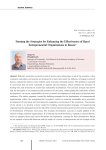
Статья научная
Political, economic and social events of recent years, taking place in all of the countries, when economic institutions and systems are destroyed in a short time under the influence of negative external factors, indicate the need to create resilient socio-economic territorial systems. This problem is essential to rural areas that are most vulnerable to negative external impacts, which confirms the relevance of finding ways and directions to ensure their sustainable development. Our previous research has shown that the formation of an entrepreneurial ecosystem of rural areas, substantiating the institutions of their development, can ensure sustainability of socio-economic development of rural areas and increase their resilience. The article proposes a model for building strategies for the development of entrepreneurial organizations within the entrepreneurial ecosystem, aimed at ensuring sustainable socio-economic development of rural areas and increasing the competitive environment of the ecosystem. The purpose of the article is to develop a factor model for building entrepreneurial strategies of entrepreneurial organizations that adequately meet the role of the rural entrepreneurial ecosystem in the current conditions of development of Russian rural areas. The strategic development concept is usually applied in the analysis of large corporate organizations. It is believed that small businesses, exposed to external factors, must use adaptive tactics and cannot formulate and implement a strategy for their development. Based on the analysis of scientific literature and the results of a survey of entrepreneurs on the example of the Sverdlovsk Oblast of the Russian Federation, we found that rural entrepreneurs seek to determine strategic directions of their development. The article presents approaches to the disclosure of relevant factors that determine the model for choosing a development strategy for rural entrepreneurial organizations. The information base of the study includes research works of Russian and foreign scientists on the topic under consideration, as well as the results of a thematic survey. The scientific novelty of the work lies in the fact that for the first time an attempt has been made to build a factor model for strategic development of rural entrepreneurs within the concept of entrepreneurial ecosystem of rural areas.
Бесплатно

